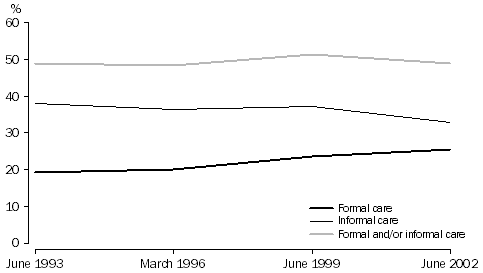LATEST FINDINGS
2001 CENSUS OF POPULATION AND HOUSING
The 2001 Census continues to be a rich source of information relating to Australia's children and youth. Data from the 2001 Census shows that there were 6.5 million children and youth (persons aged 0–24 years) in Australia on census night (representing 34% of the total Australian population). The following short article highlights how census data can be used to analyse issues affecting children and youth.
Young people using computers
Computers and the Internet are now an important part of life for young people. They are important for engaging in activities such as recreation, work, study, communication and making financial transactions. The increasing prevalence of computers and the Internet means that young people who do not have access to them can be disadvantaged by having educational outcomes adversely affected, employment opportunities restricted and other aspects of their wellbeing affected. However, there are also concerns associated with computer and Internet use, including the risk of security and privacy breaches, issues associated with Internet content and practices, and health-related issues. In the 2001 Census personal computers used at home included those used for business or private purposes, portable computers (eg laptops), personal organisers (which can be plugged into larger computers), and dedicated wordprocessors. The Census excluded dedicated gaming machines.
In 2001, around 1.5 million young people aged 15-24 years (59% of them) had use of a computer at home in the week preceding the Census. This was the highest proportion of persons in all age groups using home computers. This may be attributable to the greater exposure of young people to this technology and greater opportunities for acquiring computer skills. A similar proportion of young males and females had used a computer at home (58% and 59% respectively).
Among the youth population, 15-17 year olds were the most likely to have used a computer (72%) compared with 60% of 18-19 year olds and 50% of 20-24 year olds. Participation in education, living arrangements (in particular whether a young person is living in the family home) and financial means, are some of the factors affecting computer ownership access and use. Nearly three-quarters (74%) of young people aged 15–24 years who had used a computer at home had also used their home computer to access the Internet.
2002 CHILD CARE SURVEY
The June 2002 Child Care Survey collected information on both formal and informal child care. Formal care refers to regulated child care away from the child's home, including: preschool or kindergarten; long day care; family day care; before and after school care; and other arrangements such as crèches in shopping centres. Informal care refers to non-regulated child care either in the child's home or elsewhere including: care given by family members (such as grandparents), friends or neighbours, and paid baby-sitters. In the 1980s, the need for work-related child care increased considerably, commensurate with the increasing labour force participation of women. Along with increased use of child care for work-related reasons, the 1990s saw increases in the use of child care for parents' personal reasons.
In 2002, 49% (1,510,500) of children aged less than 12 years used some type of child care. This proportion of children aged under 12 years using child care, was relatively stable throughout the 1990s. This was mainly a result of children requiring child care because of their parents' work-related activities.
PROPORTION OF CHILDREN AGED UNDER 12 YEARS USING CHILD CARE

Informal child care is used more than formal child care. However, the proportions of children using formal child care have risen slightly over the last ten years (19% in 1993 compared with 25% in 2002), while the proportions using informal child care have declined slightly (38% in 1993 compared with 33% in 2002). In 2002 the main type of formal care used was long day care and the majority of informal care was provided by grandparents.
Further information is available in Child Care, Australia, June 2002 (cat. no 4402.0).
 Print Page
Print Page
 Print All
Print All